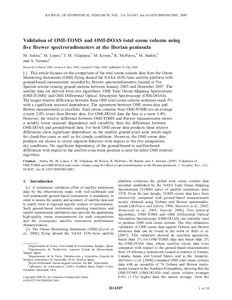Por favor, use este identificador para citar o enlazar este ítem:
http://hdl.handle.net/20.500.11765/7366
Validation of OMI-TOMS and OMI-DOAS total ozone column using five Brewer spectroradiometers at the Iberian peninsula
Registro completo de metadatos
| Campo DC | Valor | Lengua/Idioma |
|---|---|---|
| dc.contributor.author | Antón, Manuel | es_ES |
| dc.contributor.author | López, M. | es_ES |
| dc.contributor.author | Vilaplana Guerrero, José Manuel | es_ES |
| dc.contributor.author | Kroon, Mark | es_ES |
| dc.contributor.author | McPeters, Richard | es_ES |
| dc.contributor.author | Bañón García, Manuel | es_ES |
| dc.contributor.author | Serrano, Antonio | es_ES |
| dc.date.accessioned | 2017-08-01T07:44:14Z | - |
| dc.date.available | 2017-08-01T07:44:14Z | - |
| dc.date.issued | 2009 | - |
| dc.identifier.citation | Journal of Geophysical Research: Atmospheres. 2009, 114(D14), p. 1-10 | es_ES |
| dc.identifier.issn | 2169-897X | - |
| dc.identifier.issn | 2169-8996 | - |
| dc.identifier.uri | http://hdl.handle.net/20.500.11765/7366 | - |
| dc.description.abstract | This article focuses on the comparison of the total ozone column data from the Ozone Monitoring Instrument (OMI) flying aboard the NASA EOS-Aura satellite platform with ground-based measurement recorded by Brewer spectroradiometers located at five Spanish remote sensing ground stations between January 2005 and December 2007. The satellite data are derived from two algorithms: OMI Total Ozone Mapping Spectrometer (OMI-TOMS) and OMI Differential Optical Absorption Spectroscopy (OMI-DOAS). The largest relative differences between these OMI total ozone column estimates reach 5% with a significant seasonal dependence. The agreement between OMI ozone data and Brewer measurements is excellent. Total ozone columns from OMI-TOMS are on average a mere 2.0% lower than Brewer data. For OMI-DOAS data the bias is a mere 1.4%. However, the relative difference between OMI-TOMS and Brewer measurements shows a notably lower seasonal dependence and variability than the differences between OMI-DOAS and ground-based data. For both OMI ozone data products these relative differences show significant dependence on the satellite ground pixel solar zenith angle for cloud-free cases as well as for cloudy conditions. However, the OMI ozone data products are shown to reveal opposite behavior with respect to the two antagonistic sky conditions. No significant dependency of the ground-based to satellite-based differences with respect to the satellite cross-track position is seen for either OMI retrieval algorithm. | es_ES |
| dc.description.sponsorship | This work was partially supported by Ministerio de Educación y Ciencia under Project CGL2005-05693-C03-03/CLI and by Ministerio de Ciencia e Innovación under project CGL2008-05939-C03-02/CLI. | es_ES |
| dc.language.iso | eng | es_ES |
| dc.publisher | American Geophysical Union | es_ES |
| dc.subject | Total ozone column | es_ES |
| dc.subject | Aura | es_ES |
| dc.subject | Brewer | es_ES |
| dc.subject | Satellite | es_ES |
| dc.subject | Validation | es_ES |
| dc.title | Validation of OMI-TOMS and OMI-DOAS total ozone column using five Brewer spectroradiometers at the Iberian peninsula | es_ES |
| dc.type | info:eu-repo/semantics/article | es_ES |
| dc.relation.publisherversion | htpps://dx.doi.org/10.1029/2009JD012003 | es_ES |
| dc.rights.accessRights | info:eu-repo/semantics/openAccess | es_ES |
| Colecciones: | Artículos científicos 2005-2009 | |
Ficheros en este ítem:
| Fichero | Descripción | Tamaño | Formato | ||
|---|---|---|---|---|---|
| Lopez Bartolome et al... | 1,07 MB | Adobe PDF |  Visualizar/Abrir |
Los ítems de Arcimis están protegidos por una Licencia Creative Commons, salvo que se indique lo contrario.





